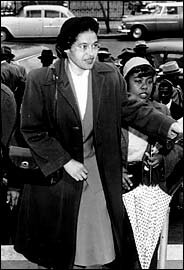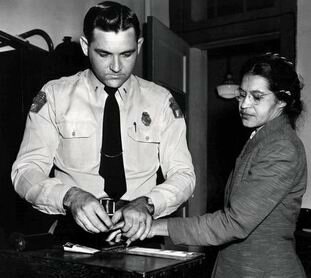|
 Rosa Parks, a black seamstress whose refusal to relinquish her seat to a white man on a city bus in Montgomery, Ala., almost 50 years ago grew into a mythic event that helped touch off the civil rights movement of the 1950's and 1960's, died yesterday at her home in Detroit. She was 92 years old. Rosa Parks, a black seamstress whose refusal to relinquish her seat to a white man on a city bus in Montgomery, Ala., almost 50 years ago grew into a mythic event that helped touch off the civil rights movement of the 1950's and 1960's, died yesterday at her home in Detroit. She was 92 years old.
For her act of defiance, Mrs. Parks was arrested, convicted of violating the segregation laws and fined $10, plus $4 in court fees. In response, blacks in Montgomery boycotted the buses for nearly 13 months while mounting a successful Supreme Court challenge to the Jim Crow law that enforced their second-class status on the public bus system.
The events that began on that bus in the winter of 1955 captivated the nation and transformed a 26-year-old preacher named Martin Luther King Jr. into a major civil rights leader. It was Dr. King, the new pastor of the Dexter Avenue Baptist Church in Montgomery, who was drafted to head the Montgomery Improvement Association, the organization formed to direct the nascent civil rights struggle.
"Mrs. Parks's arrest was the precipitating factor rather than the cause of the protest," Dr. King wrote in his 1958 book, "Stride Toward Freedom. "The cause lay deep in the record of similar injustices."
Her act of civil disobedience, what seems a simple gesture of defiance so many years later, was in fact a dangerous, even reckless move in 1950's Alabama . In refusing to move, she risked legal sanction and perhaps even physical harm, but she also set into motion something far beyond the control of the city authorities. Mrs. Parks clarified for people far beyond Montgomery the cruelty and humiliation inherent in the laws and customs of segregation.
That moment on the Cleveland Avenue bus also turned a very private woman into a reluctant symbol and torchbearer in the quest for racial equality and of a movement that became increasingly organized and sophisticated in making demands and getting results.
"She sat down in order that we might stand up," the Rev. Jesse Jackson said yesterday in an interview from South Africa . "Paradoxically, her imprisonment opened the doors for our long journey to freedom."
Over the years myth tended to obscure the truth about Mrs. Parks. One legend had it that she was a cleaning woman with bad feet who was too tired to drag herself to the rear of the bus. Another had it that she was a "plant" by the National Association for the Advancement of Colored People.
The truth, as she later explained, was that she was tired of being humiliated, of having to adapt to the byzantine rules, some codified as law and others passed on as tradition, that reinforced the position of blacks as something less than full human beings.
"She was fed up," said Elaine Steele, a longtime friend and executive director of the Rosa and Raymond Parks Institute for Self Development. "She was in her 40's. She was not a child. There comes a point where you say, 'No, I'm a full citizen, too. This is not the way I should be treated.' "
In "Stride Toward Freedom," Dr. King wrote, "Actually no one can understand the action of Mrs. Parks unless he realizes that eventually the cup of endurance runs over, and the human personality cries out, 'I can take it no longer.' "
Mrs. Parks was very active in the Montgomery N.A.A.C.P. chapter, and she and her husband, Raymond, a barber, had taken part in voter registration drives.
At the urging of an employer, Virginia Durr, Mrs. Parks had attended an interracial leadership conference at the Highlander Folk School in Monteagle, Tenn. , in the summer of 1955. There, she later said, she "gained strength to persevere in my work for freedom, not just for blacks but for all oppressed people."
But as she rushed home from her job as a seamstress at a department store on Dec. 1, 1955, the last thing on her mind was becoming "the mother of the civil rights movement," as many would later describe her. She had to send out notices of the N.A.A.C.P.'s coming election of officers. And she had to prepare for the workshop that she was running for teenagers that weekend.
"So it was not a time for me to be planning to get arrested," she said in an interview in 1988.
On Montgomery buses, the first four rows were reserved for whites. The rear was for blacks, who made up more than 75 percent of the bus system's riders. Blacks could sit in the middle rows until those seats were needed by whites. Then the blacks had to move to seats in the rear, stand or, if there was no room, leave the bus. Even getting on the bus presented hurdles: If whites were already sitting in the front, blacks could board to pay the fare but then they had to disembark and re-enter through the rear door.
For years blacks had complained, and Mrs. Parks was no exception. "My resisting being mistreated on the bus did not begin with that particular arrest," she said. "I did a lot of walking in Montgomery."
After a confrontation in 1943, a driver named James Blake ejected Mrs. Parks from his bus. As fate would have it, he was driving the Cleveland Avenue bus on Dec. 1, 1955. He demanded that four blacks give up their seats in the middle section so a lone white man could sit. Three of them complied.
Recalling the incident for "Eyes on the Prize," a 1987 public television series on the civil rights movement, Mrs. Parks said: "When he saw me still sitting, he asked if I was going to stand up and I said, 'No, I'm not.' And he said, 'Well, if you don't stand up, I'm going to have to call the police and have you arrested.' I said, 'You may do that.' "
Her arrest was the answer to prayers for the Women's Political Council, which was set up in 1946 in response to the mistreatment of black bus riders, and for E. D. Nixon, a leading advocate of equality for blacks in Montgomery.
 Blacks had been arrested, and even killed, for disobeying bus drivers. They had begun to build a case around a 15-year-old girl's arrest for refusing to give up her seat, and Mrs. Parks had been among those raising money for the girl's defense. But when they learned that the girl was pregnant, they decided that she was an unsuitable symbol for their cause. Blacks had been arrested, and even killed, for disobeying bus drivers. They had begun to build a case around a 15-year-old girl's arrest for refusing to give up her seat, and Mrs. Parks had been among those raising money for the girl's defense. But when they learned that the girl was pregnant, they decided that she was an unsuitable symbol for their cause.
Mrs. Parks, on the other hand, was regarded as "one of the finest citizens of Montgomery - not one of the finest Negro citizens - but one of the finest citizens of Montgomery," Dr. King said.
While Mr. Nixon met with lawyers and preachers to plan an assault on the Jim Crow laws, the women's council distributed 35,000 copies of a handbill that urged blacks to boycott the buses on Monday, Dec. 5, the day of Mrs. Parks's trial.
"Don't ride the buses to work, to town, to school, or anywhere on Monday," the leaflet said.
On Sunday, Dec. 4, the announcement was made from many black pulpits, and a front-page article in The Montgomery Advertiser, a black newspaper, further spread the word.
Some blacks rode in carpools that Monday. Others rode in black-owned taxis that charged only the bus fare, 10 cents. But most black commuters - 40,000 people - walked, some more than 20 miles.
At a church rally that night, blacks unanimously agreed to continue the boycott until these demands were met: that they be treated with courtesy, that black drivers be hired, and that seating in the middle of the bus go on a first-come basis.
The boycott lasted 381 days, and in that period many blacks were harassed and arrested on flimsy excuses. Churches and houses, including those of Dr. King and Mr. Nixon, were dynamited.
Finally, on Nov. 13, 1956, in Browder v. Gayle, the Supreme Court outlawed segregation on buses. The court order arrived in Montgomery on Dec. 20; the boycott ended the next day. But the violence escalated: snipers fired into buses as well as Dr. King's home, and bombs were tossed into churches and into the homes of ministers.
Early the next year, the Parkses left Montgomery for Hampton, Va., largely because Mrs. Parks had been unable to find work, but also because of disagreements with Dr. King and other leaders of the city's struggling civil rights movement.
Later that year, at the urging of her younger brother, Sylvester, Mrs. Parks, her husband and her mother, Leona McCauley, moved to Detroit. Mrs. Parks worked as a seamstress until 1965, when Representative John Conyers Jr. hired her as an aide for his Congressional office in Detroit. She retired in 1988.
"There are very few people who can say their actions and conduct changed the face of the nation," Mr. Conyers said yesterday in a statement, "and Rosa Parks is one of those individuals."
In the last decade, Mrs. Parks was awarded the Presidential Medal of Freedom and the Congressional Gold Medal. But even as she remained an icon of textbooks, her final years were troubled. She was hospitalized after a 28-year-old man beat her in her home and stole $53. She had problems paying her rent, relying on a local church for support until last December, when her landlord stopped charging her rent.
Rosa Louise McCauley was born in Tuskegee, Ala., on Feb. 4, 1913, the elder of Leona and James McCauley's two children. Although the McCauleys were farmers, Mr. McCauley also worked as a carpenter and Mrs. McCauley as a teacher.
Rosa McCauley attended rural schools until she was 11 years old, then Miss White's School for Girls in Montgomery. She attended high school at the Alabama State Teachers College, but dropped out to care for her ailing grandmother. It was not until she was 21 that she earned a high school diploma.
Shy and soft-spoken, Mrs. Parks often appeared uncomfortable with the near-beatification bestowed upon her by blacks, who revered her as a symbol of their quest for dignity and equality. She would say that she hoped only to inspire others, especially young people, "to be dedicated enough to make useful lives for themselves and to help others."
She also expressed fear that since the birthday of Dr. King became a national holiday, his image was being watered down and he was being depicted as merely a "dreamer."
"As I remember him, he was more than a dreamer," Mrs. Parks said. "He was an activist who believed in acting as well as speaking out against oppression."
She would laugh in recalling some of her experiences with children whose curiosity often outstripped their grasp of history: "They want to know if I was alive during slavery times. They equate me along with Harriet Tubman and Sojourner Truth and ask if I knew them."
By E. R. SHIPP - The New York Times, October 25, 2005.
|
